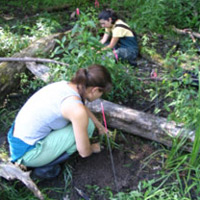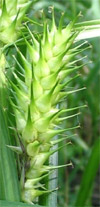Volume 10, Issue 03
October 2007
bulletin
français

| Subscription information If you would like to subscribe, have any questions or if would like to contribute a news item, please contact Yann Vergriete, newsletter editor or David Gailbraith, CBCN executive director: yannvergriete@fastmail.fm dgalbraith@rbg.ca |
|
1. Urgence Conservation: The involvement of the Montréal Botanical Garden in the safeguarding of Quebec’s plant heritage, Stéphanie Pellerin, Institut de recherche en biologie végétale, The Montréal Botanical Garden
In 2001 the Montréal Botanical Garden inaugurated the Urgence-Conservation program, with the aim of conserving off-site the threatened flora of Southern Quebec. At the time, a score of rare species were already present in the collections of the Garden. Today, due to harvest and propagation activities, the collection of rare Quebec plants at the Montréal Botanical Garden has risen to 104 species. Although the off-site conservation is a worthwhile venture, it is not meant to replace the conservation efforts in the natural environment. Accordingly, a new phase aiming at on-site conservation of rare plants was added in 2006 to the Urgence-Conservation program. The first project that has come out of this new approach relates to the Carex lupulina, a species from Eastern North America which grows mostly in marshes and in the openings of silver maple populated swamplands. In the United States it is considered to be in a precarious situation in almost all the states where it is present. In Canada, where it is present only in Southern Ontario and Quebec, it is considered to be on the verge of extinction, meaning that its disappearance is imminent. The principal threats to its survival are the destruction of its habitat by humans, the invasion of competitive exotic species, such as Reed Canary Grass (Phalaris arundinacea), but especially because of the small number of its population groupings (seven population groupings overall, wherein two are in Quebec), and their extremely reduced size (in general less than 20 individual plants per population grouping).
This project was made possible thanks to the support of WWF-Canada, Environment Canada, and the Friends of the Montréal Botanical Garden. Bottom image of Carex lupuliformis Sartwell
|

 The
strategy developed in order to ensure the long-term survival of
Carex lupulina comprises three principal actions: the search
for new populations, monitoring of those existing populations, and
an increase in manpower devoted to their conservation. Although
it is still too early to evaluate the effects of the re-introduction
project, the first indicators are very encouraging. Indeed, a new
population grouping was found, and our efforts of species re-introduction
have made it possible to increase the manpower involved in the project
from about 30 individuals within two localities to more than 200
individuals within six localities! Thanks to the increase in manpower,
we hope to ensure the survival of the species, as well as its place
within Quebec’s plant biodiversity.
The
strategy developed in order to ensure the long-term survival of
Carex lupulina comprises three principal actions: the search
for new populations, monitoring of those existing populations, and
an increase in manpower devoted to their conservation. Although
it is still too early to evaluate the effects of the re-introduction
project, the first indicators are very encouraging. Indeed, a new
population grouping was found, and our efforts of species re-introduction
have made it possible to increase the manpower involved in the project
from about 30 individuals within two localities to more than 200
individuals within six localities! Thanks to the increase in manpower,
we hope to ensure the survival of the species, as well as its place
within Quebec’s plant biodiversity. 
